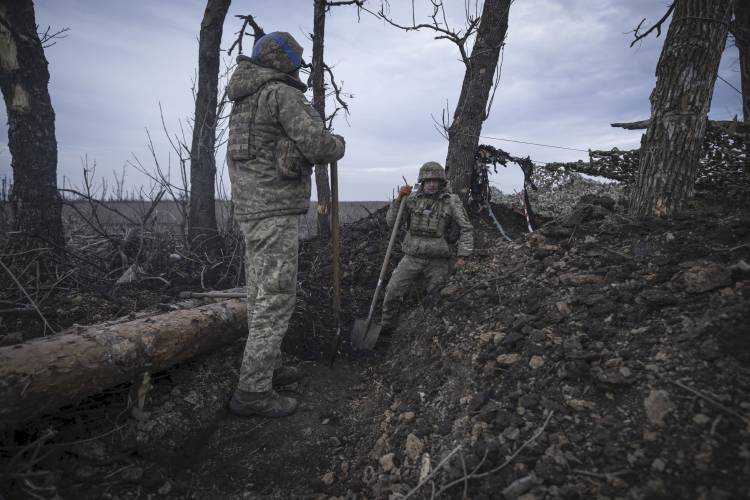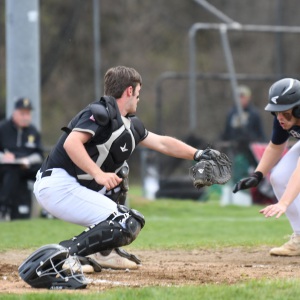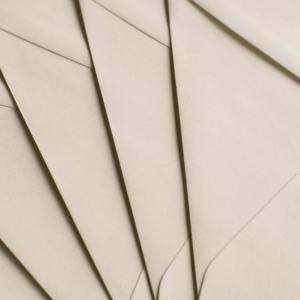As I See It: How to end the war in Ukraine

Ukrainian soldiers dig a trench on the front-line near Klishchiivka, Donetsk region, Ukraine, Monday, March 18, 2024. IRYNA RYBAKOVA VIA AP
|
Published: 03-22-2024 2:15 PM
Modified: 03-22-2024 8:09 PM |
Putin rattles his nuclear saber again: The Associated Press reports, “Putin says Russia is ready to use nuclear weapons” [Recorder, March 14]. He has been making such threats for the past two years, especially against the possibility of the U.S. or NATO sending ground troops. The CIA says “it’s 50-50” that he will do it (which prompted Biden’s famous “Armageddon” speech), and that’s frightening enough.
The latest conclusion from the Ukrainian front is that both sides are exhausted, neither side able to make a decisive move. This stalemate is bad news for Ukraine, as Russia still has a deeper pool of everything — manpower, resources and authority to last longer, perhaps forever with its national patience.
The Western alliance, especially the United States, is showing cracks and is thin on patience. Only last week, the pope advised Ukraine to surrender, with “the courage of the white flag.” Other nations will advise likewise. Unlike the Russians, patience is not the West’s, or America’s, strong suit. While neither side seems capable of a decisive outcome, a lot of damage can be inflicted by both sides in a war of attrition.
Such a grim and seemingly hopeless war is also an opportunity in search of radical solutions and I have just imagined one myself. I believe my solution will end the war in Ukraine’s favor — without more nuclear threats from Mr. Putin or further drains from the West’s treasuries.
My solution requires two well-defined but simple policy actions by our government:
First Action: Under cover of secrecy, install three high-powered American nuclear warheads in Ukraine, and then announce that Ukraine has the nuclear capability to destroy Moscow, which is merely 500 miles away, just minutes of flight time from Ukraine. This action neutralizes Putin’s nuclear threats.
With only three warheads, the Kiev government can invalidate Putin’s dangerous nuclear temptations with his own mutually assured destruction (MAD).
Russia will protest, of course. But, according to the 1994 treaty they signed along with the United States, now known as “The Budapest Memorandum,” actually the Russians are obligated, morally and legally, to restore Ukraine’s nuclear capability. Since Russia is obviously unwilling to do this, the U.S., its co-signer, will have to do it, as all co-signers must do for the delinquent debtors.
Article continues after...
Yesterday's Most Read Articles
 Serious barn fire averted due to quick response in Shelburne
Serious barn fire averted due to quick response in Shelburne
 Bridge of Flowers in Shelburne Falls to open on plant sale day, May 11
Bridge of Flowers in Shelburne Falls to open on plant sale day, May 11
 Political newcomer defeats Shores Ness for Deerfield Selectboard seat
Political newcomer defeats Shores Ness for Deerfield Selectboard seat
 Roundup: Pioneer baseball wins Suburban League West title following 2-0 win over Hopkins
Roundup: Pioneer baseball wins Suburban League West title following 2-0 win over Hopkins
 As I See It: Between Israel and Palestine: Which side should we be on, and why?
As I See It: Between Israel and Palestine: Which side should we be on, and why?
 Employee pay, real estate top Erving Town Meeting warrant
Employee pay, real estate top Erving Town Meeting warrant
How did the Budapest Memorandum come about?
While the Soviet Union was still the world’s second largest nuclear power, it just so happened that the Soviets had stationed 1,700 nuclear warheads in Ukraine, then part of the Soviet Union. When the Soviet Union was no more as a nation, Ukraine suddenly ended up with those Soviet-made nuclear warheads on its soil, 1,700 of them, effectively making it the third most powerful nuclear-armed nation in the world.
With this many windfall warheads, however, the pressure on Ukraine was intense from the international community to give them up. Ukraine finally agreed to give up its nuclear arsenal in exchange for the absolute guarantee of its national security by three nations — the United States, Great Britain and Russia (as the successor to the Soviet Union).
After two years of bloody war that they did not start, are the Ukrainians sorry that they gave up their real guarantor of peace? Of course they are. Putin’s Russia would have never invaded Ukraine if those nuclear weapons were still on Ukrainian soil. Obviously, as far as the Russians were concerned, the security guarantee in the Memorandum was not worth the paper it was written on. The Russians invaded Ukraine anyway.
Returning three warheads for the 1,700 warheads they took from Ukraine under a now-broken promise, and under false pretenses, is fair enough. In America’s own business practices, guarantees are sacrosanct. Both Russia and the U.S. guaranteed Ukraine’s sovereignty and at least one signer should be willing to restore the promise.
Second Action: In order to win the ground war in Ukraine, follow the announcement of Ukraine’s newly restored nuclear capability with another bombshell announcement: that the U.S., augmented by NATO, will send ground troops to Ukraine to fight the Russians. This will end the ground war in Ukraine, very likely, without firing a shot.
Once his nuclear wings are clipped with Kiev’s own MAD capability, Putin’s nuclear bluff is over. In the ground war, he is exhausted —materially, strategically and spiritually — and Russians are no match for the American GIs who are famously well-fed, well-armed and well-rested. All the U.S. has to do is announce its plan to send a small advance unit to the Ukrainian front, with more to follow, and Putin will shake in his boots at the very news that the Yanks are coming!
Just as in Reagan’s Cold War strategy, the U.S. can outmuscle the Russians with its sheer material superiority. This new phase of the war in Ukraine will be won even before it starts. The Russian people will not, and cannot, support Putin gearing up for a fresh round of war against the well-fed, well-armed and well-rested Americans with high-tech war machines.
In his exhausted state — and with no nuclear options to consider — Putin has no other choice. As long as Kiev holds its MAD dagger aimed at Moscow so close, Russia will never invade Ukraine or another nation west of Ukraine again.
For the U.S., this daring coup of the century will help Democrats score a few electoral wins and, not insignificantly, for Joe Biden come November. It’s a win-win-win solution — morally, practically and strategically.
Jon Huer, columnist for the Recorder and retired professor, lives in Greenfield.

 My Turn: Stop taking all equity in home seizures now
My Turn: Stop taking all equity in home seizures now Robert McGahan: Will Emmet selflessly gives time and energy to town
Robert McGahan: Will Emmet selflessly gives time and energy to town Pam Roberts: Come join Buddy Baseball's new season on May 11!
Pam Roberts: Come join Buddy Baseball's new season on May 11! Bill and Jean Gran: Heath Select Board needs Mike Smith’s broad experience
Bill and Jean Gran: Heath Select Board needs Mike Smith’s broad experience
